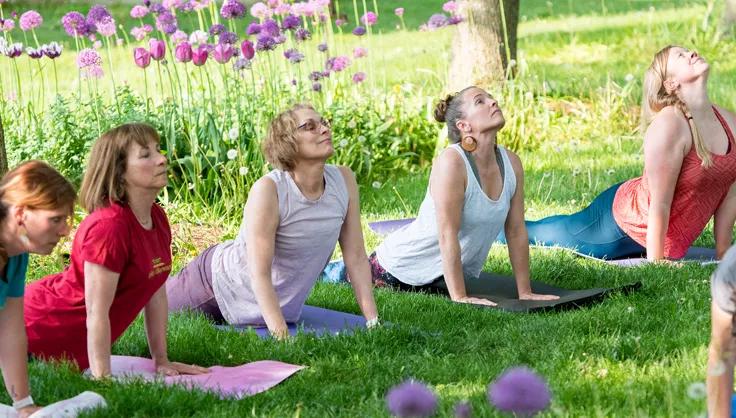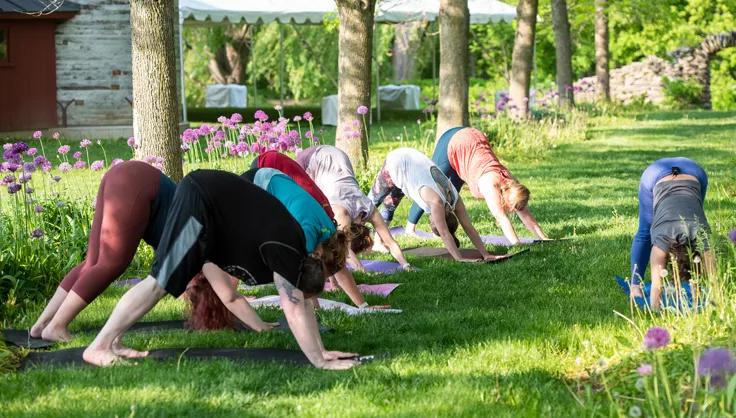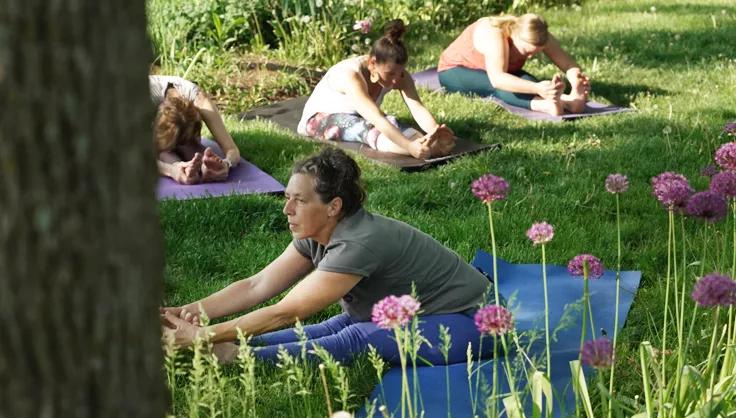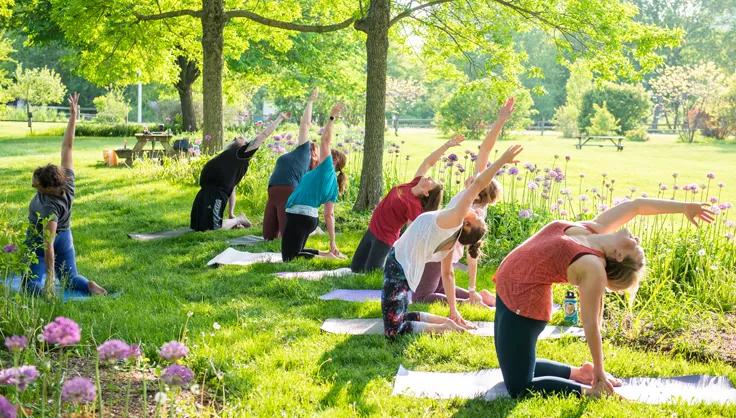Yoga for Gardeners: Cultivate Strength, Flexibility & Serenity
6 Simple Yoga Poses to Prepare and Rejuvenate Your Body for Gardening Bliss
Gardening helps to strengthen bodies, increase flexibility, cultivate an inner calm, and alleviate anxiety — but as good as it feels in the moment, some of the more repetitive motions can also take a toll on your body, leading to tight muscles, and aches and pains in joints. Something else that helps to increase strength, flexibility, and serenity? Yoga! So, we asked registered yoga teacher Kathy McNames, of Yoga Vermont to share some simple poses that can help invigorate and rejuvenate gardeners warming up and cooling down from gardening activities.
6 Yoga Poses To Enhance Your Gardening Experience
These stretching and strengthening yoga poses are appropriate for beginners as well as experienced yogis. All of these poses are just as effective whether you’re practicing outdoors in the garden or in the comfort of your living room. To ensure your safety and comfort, be gentle with your body and heed your doctor's directives.
Pose 1: Finger Flex and Shoulder Stretch
Our hands and arms bear the brunt of our gardening tasks. Clenching stubborn weeds and hefting hand tools around can fatigue your upper body in a hurry. Treat your hands, arms, and upper shoulders to a deep stretch.

How to: Begin by rotating your hands slowly in both directions to loosen wrists. Then, with palms facing outward, use one hand to gently flex each individual finger on the opposite hand. Don’t forget to switch hands. Now it’s time to get into the upper arms. Spread your arms out wide, then cross them in front of your chest with elbows bent and fingers pointing skyward. One elbow will be tucked inside the opposite inner arm. Bring the backs of the hands together or wrap your hands around each other one more time so palms are together, for an even deeper stretch.
What does it target: Fingers, hands, arms, shoulders
Pose 2: Upward Facing Dog
Let’s face it; in the garden, you are mostly facing down towards the ground. Continuous hunching forward can do a number on your upper back. Counter that all that slumping with this powerful chest-opening pose.

How to: Lie belly-first down on the ground with your hands next to your ribs and your elbows tucked in close to your body. Press the tops of your feet into the ground. As you inhale, press into your hands, straighten your arms and lift your chest up off the ground. Envision your heart pulling your upper body forward and through your arms. It’s easy to scrunch into your shoulders here; try to gently draw your shoulders down and back to get the most of this chest-opener.
What does it target: Chest, neck, shoulders
Pose 3: Downward Facing Dog
One of the most recognizable yoga poses, downward dog strengthens arms and shoulders (you’ll need those for lugging all that potting soil around, after all), stretches your calves, and over time, loosens low back tension.

How to: Start on your hands and knees. Tuck the toes under, press into your hands, and begin to lift the hips skyward. You’ll form an upside-down V with your body. Keep your fingers spread apart and facing forward. Let your head and neck relax. Don’t worry about straightening your legs; the goal is to lengthen your spine and press your chest towards your thighs.
What does it target: Arms, shoulders, lower back, calves
Pose 4: Upward Salute
This is an energizing and uplifting full body stretch to do before, during, or after a stint in the garden. It provides the opportunity to look up, observe the horizon, and breathe fully and deeply. Plus, it just feels plain good!

How to: Stand with feet together and arms at your side. Ground down through all four “corners” of your feet and stand tall. As you inhale, sweep your arms overhead. Keep your arms parallel or bring your palms together; either way, keep your arms long and active from shoulder to fingertips. Lift your gaze skyward.
What does it target: Shoulders, neck, arms, core
Pose 5: Extended Side Angle
This is an excellent side body stretch that also builds hip and core strength. A strong core supports good posture and prevents future back injuries.

How to: Begin standing facing forward with feet parallel to each other. Step your left foot back and angle it outward — your front foot will face forward while your back foot will angle outward somewhere between 45- and 90- degrees. Bend your right knee at a 90-degree angle, so your thigh is parallel to the ground. Rest your right forearm on the right thigh with the palm facing skyward. Reach your left arm up and extend it over the ear. Imagine creating a long line from your ankle through your wrist. Breathe deeply into the left side of your body. Looking for a deeper hip stretch? Bring your right hand down to the ground. Don’t forget to switch sides!
What does it target: Hips, core
Pose 6: Seated Forward Bend
After a busy session in the garden, take a moment to quiet your mind while simultaneously creating a deep stretch for the entire back of the body. This is not a “can you touch your toes” challenge, but rather a “stretch your spine long” exercise.

How to: Sit with your legs together or hip-width apart, and straight in front of you. Inhale and reach with both arms skyward, then, as you exhale, reach and bend forward at the hips, reaching with your hands toward your toes. Looking for a challenging modification? Draw one foot in to your inner thigh and “cradle” it in your arms to deepen the stretch in your hip joint.
What does it target: Upper and lower back, hips, hamstrings
Tips For Starting Your Own Outdoor Garden Yoga Practice
- Aim to practice barefoot so you can feel and grip every contour of the ground. Bare feet are better at finding balanced contact with uneven ground. A regular barefoot practice also helps to build up those unused foot muscles. Experiment with lifting your toes up off the ground and setting them down one by one.
- With an outdoor practice, you will be sure to encounter sudden gusts of wind, annoying insects, or a neighbor’s ill-timed lawn mower. Allow yourself to notice these disturbances and understand that they are temporary and don’t need to detract from your enjoyment. Life is, after all, not a silent, climate-controlled yoga studio; it’s full of interruptions and distractions. Finding an inner sense of calm amongst those disturbances takes practice.
- Take this opportunity to observe your garden from a whole new angle. Sure, you stand over your plants with the watering wand every week, but have you ever seen the underside of those zinnias while in downward facing dog? While folding into a forward bend, did you happen to glimpse the tips of asparagus starting to emerge?
- Let your other senses kick in while you practice. Listen to the rustle of grasses and the sound of bees hovering nearby. Breathe deeply and take note of the fragrant lilac beginning to bloom.
- Now for the practical — be liberal with sunscreen before you begin, drink water during, and do a quick tick check after your outdoor practice.
Gardening As Moving Meditation
Activities like yoga, walking, and tai chi, and yes, even gardening are all forms of moving meditation. Tasks that we do regularly, and often on autopilot, can be opportunities to sow a sense of tranquility. Rather than rushing through the not-so-pleasant garden jobs (i.e. edging the grass, hauling mulch, pulling stubborn weeds, insert your least favorite garden task here), instead pay close, curious attention to each movement. Focus on each action you make and how it progressively results in tidier beds, healthier plants — and a more centered you.
Last updated: 06/06/2023
Print this Article:
Get the Dirt
Stay up to date on new articles and advice. Please fill out the information below.


